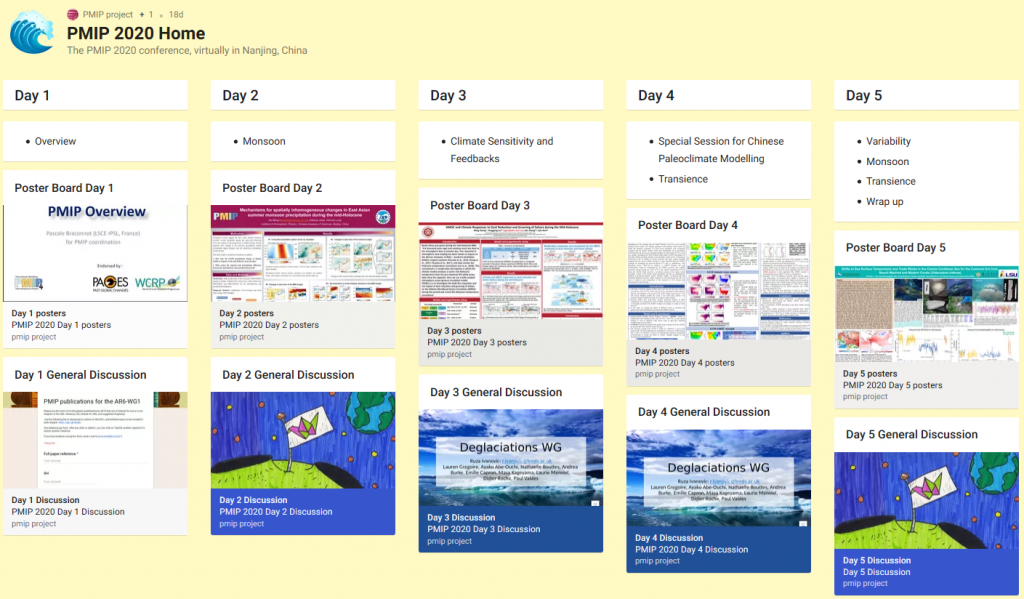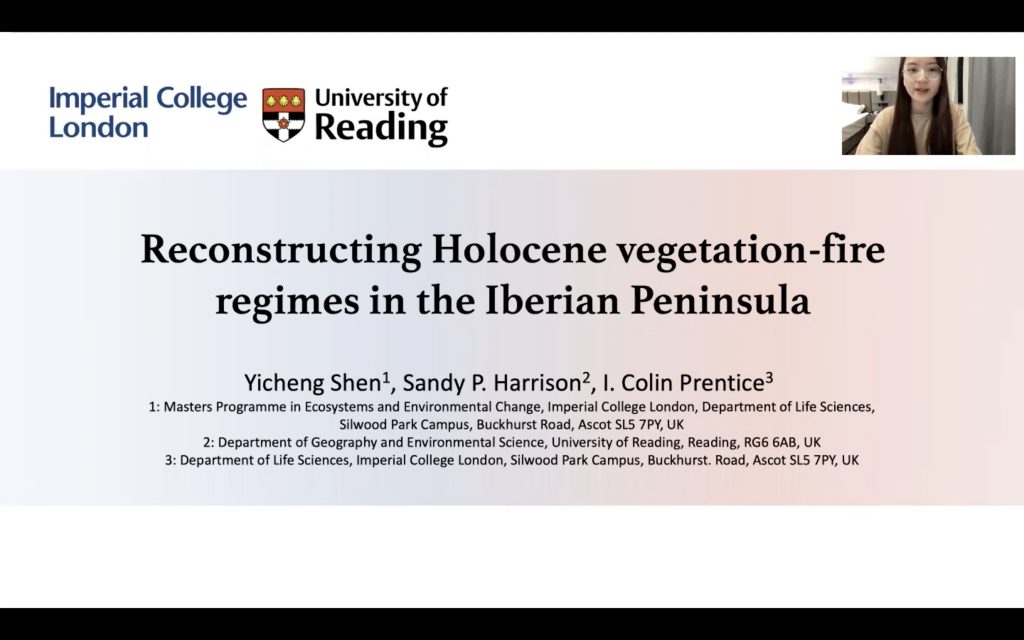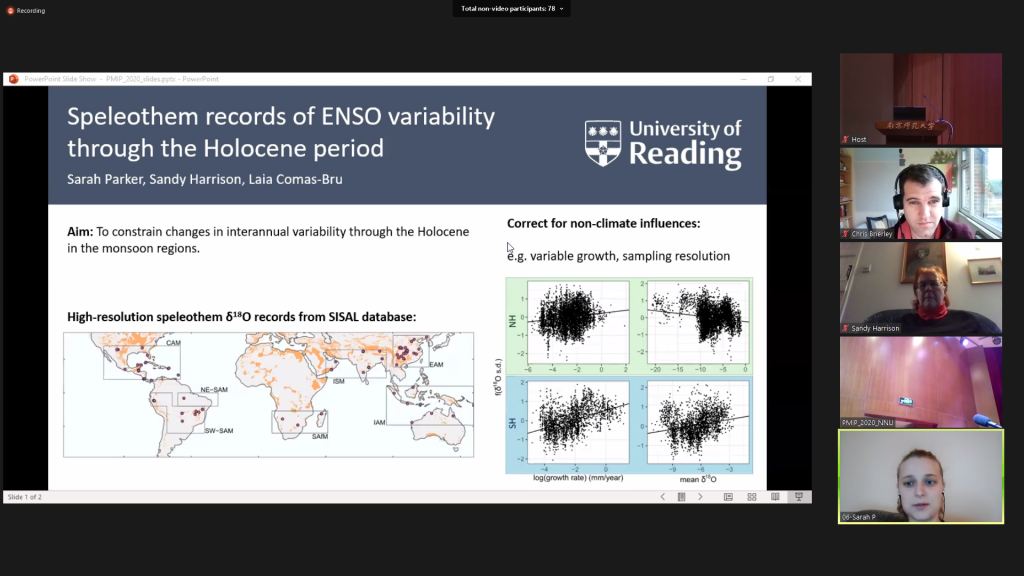The Paleoclimate Modelling Intercomparison project (PMIP; https://pmip.lsce.ipsl.fr/), which began in the early 1990s to provide an efficient mechanism for coordinating palaeoclimate modelling activities, held it’s biannual meeting in Nanjing (China) on 26-30 October 2020. Due to COVID-19, the conference was held through Zoom and Padlet for everyone who could not travel to Nanjing. All posters were put online, and people left their questions or comments using Padlet. Anyone could write comments no matter if you are an expert or just a beginner (but some of us didn’t have enough courage to stand out to make comments…).
 Padlet used to keep track of the discussions / posters and activities taking place during the PMIP2020 meeting.
Padlet used to keep track of the discussions / posters and activities taking place during the PMIP2020 meeting.
The following members of the SPECIAL group (along with Sandy) attended the on-line meeting from home: Sarah Parker (PhD student), Mengmeng Liu (PhD student), Yicheng Shen (Master student), Pablo Paiewonsky (PDRA) and Laia Comas-Bru (PDRA). We all agree on how amazing it was to see people from different countries discussing together and setting up connections for future cooperation. Here are individual reactions from our group:
Yicheng Shen’s experience:
It is an awesome experience for me because this is my first time attending an international conference. To be honest, I often felt hard to follow some of the presenters due to the lack of knowledge. But this conference provided me a good opportunity to learn more things about palaeoclimate changes and feedback on different time scales, various climate models… Palaeo key questions were also pointed out through presentations and discussions which are helpful for planning my future research.
The most impressive part for me is when people discuss the IPCC report on the first day maybe because I am always interested in working in the IPCC. The importance of palaeoclimate studies are surely worthwhile to put emphasis on, but at the same time, a bridge connecting scientists and policymakers should be built carefully (and my dream job is to be this “bridge”). Also, it is great to hear that palaeoclimate evidence is included in the latest report which I think is a great start that more people realized that the results of palaeoclimate studies are as valuable as modern climate studies.
It was exciting to present my master project towards all PMIPers, and it seems like I am the only one talking about the palaeofire. But I feel that studies on palaeofire and palaeoclimate have many commons, not only their methodologies but also their limitations. Lastly, big thanks for this great opportunity and I really enjoyed that. And I hope that I will be there at the next PMIP conference in Paris!
 Yicheng’s presentation at PMIP2020
Yicheng’s presentation at PMIP2020
Pablo Paiewonsky’s experience:
The zoom format lent itself to a more intimate and convivial environment. I was very impressed by this and proud to be part of this community. Research topics ranged widely with simulations by different models and different eras: mid-Pliocene, last interglacial, last glacial maximum, mid-Holocene, last millennium, and transient runs of the last deglaciation and Holocene. There was modeling of oxygen isotopes and carbon isotopes, vegetation distributions, and many atmospheric and oceanic climate variables. Research questions involved the the role of the Tibetan Plateau on climate, the effect of the Green Sahara on outside climate, ENSO under altered climates, volcanic forcing’s impact on climate, and dust’s impact on the atmosphere and the atmospheric-oceanic carbon cycle.
The discussion sections often focused on the role of the paleoclimate modeling community within Earth system and global change sciences, especially the IPCC; near-term and long term research needs and goals; and how to structure and improve the upcoming PMIP conferences.
Two particularly well-received talks were the one by Steven Sherwood on climate sensitivity and Marie Kapsch’s presentation on a long transient deglaciation simulation using the MPI Earth System Model.
My personal favorite sets of research were the simulations of the Holocene global temperature evolution that showed how adding reconstructed volcanic aerosol forcing changed the progression from an increase throughout the Holocene to one showing the reconstructed early-mid Holocene peak.
Mengmeng’s experience:
This is the second online conference I attended. The first one is EGU. COVID-19 might last for years and we may have to arrange our life with its existence, so online conferences might become common in the next several years.
I feel that PMIP is more interactive for me, probably because the group is smaller and my research matches more. PMIP and EGU adopt a similar presenting format for posters, people can comment below and the author can reply. They make me find that ideas can be successfully exchanged without face-to-face talk, although not as interactive as presenting posters in person and you can’t walk around looking at others’ posters and talk to them. I really like the 2 min quick presentations and the following whole group discussions.
The discussions are very impressive. In academia, scientists often have to either publish or perish. You have to admit the existence of someone who just does research on what they think is easy to publish in good journals by including hotspot points and some fancy techniques, without actually thinking about the real scientific questions. PMIP, however, has no such individuals. People talk about what is not known, what is not solved, what can be done, who can do what, etc. This is what science should be. We shouldn’t do science without even thinking about how to make a living, however, we also shouldn’t go to the opposite side: do science without science.
Sarah’s experience:
The PMIP 2020 conference saw me pulling myself out of bed every morning, making a strong mug of coffee and sitting down at my laptop ready for 7am, tired but still excited for the talks ahead. By this point in 2020, I consider myself adept at using zoom (mute microphone, turn off webcam, enter…), and this platform allowed the conference to run smoothly with people joining from an impressively large range of countries. I was presenting my research on monsoon speleothem records of interannual variability, as a poster and 2-minute lightening talk. There was a broad range of posters that overlapped with my research, in particular posters from the “monsoon” theme on day 2, and the posters on ENSO and internal variability on day 5. Overall, the conference allowed me to expand my knowledge with respect to my research area and interact with academics across the globe from the comfort of my sofa.
 Sarah Parker presenting her PhD work
Sarah Parker presenting her PhD work
Laia’s experience:
This was the second time I attended a PMIP meeting and the fact that it was done on-line due to the current situation, helped to stay focused on what was being presented. There’s nothing like the comfort of your own home to get ready for early morning talks.
The main point that I got out of the meeting was that better connections with the data community are needed to move forward with model evaluation and to make sure that data-model comparisons are done sensibly. As a researcher working with both, observations and modelling data, I am always surprised by the few “data people” that seem to be involved in PMIP activities… I believe both communities would benefit from an improved communication!

